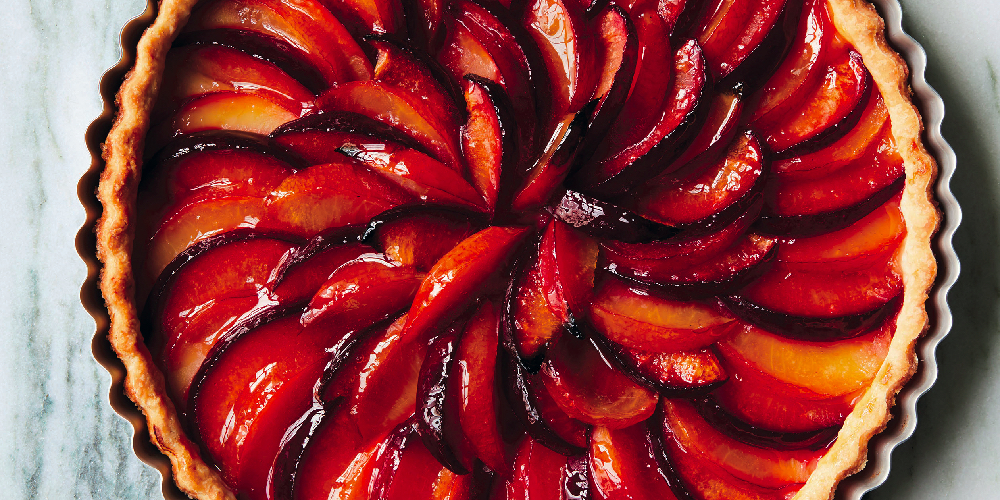
Caramelised plum tart

Serves: 8
You may know rue Lepic from the movie Amélie. It is hard to imagine a more charming market street, complete with a cheesemonger, a butcher’s shop, a fish stall, a spice vendor, a charcuterie, a rôtisserie, and more speciality shops than you can shake a baguette at. I showcase it on my tasting tours of Montmartre, and always pause at Les Petits Mitrons (The Baker’s Apprentices). The pink-and-blue pastry shop has stopped passers-by in their tracks since 1982 with its display of fruit tarts arranged on round cooling racks, seemingly straight out of a French grandmother’s oven: perfectly imperfect, with jagged edges and simple patterns of seasonal fruits you would swear were picked from a garden in the back. Even more irresistible than the fruits is the sugar-studded, heavily caramelised, crunchy rim. The secret to this crust is a closely guarded one, but I created a copycat recipe.
I like to make this tart in late summer to show off the rainbow range of French plums: purple quetsches, green reines-claudes, yellow mirabelles. That said, it can be made with any combination of seasonal fruits: berries, figs, cherries, stone fruits, apples, pears . . .
Ingredients
- 2 teaspoons (10g) unsalted butter
- ¼ cup (50g) sugar
- Tart pastry (see recipe below)
- 1¾ pounds (800g) just-ripe, small plums (see Note)
- ¼ cup (60ml) apricot jam
Directions
1Grease a 10-inch (25cm) metal tart pan with a removable bottom (see Note) with the butter, and sprinkle the bottom and sides evenly with the sugar. Roll out the pâte brisée and line the pan with it, trimming the excess with a roll of the pin. Let rest for 30 minutes in the refrigerator.
2Preheat the oven to 425°F (220°C). (If your oven has a mode where the heat comes primarily from the bottom heating element, use this; it will foster a deeper caramelisation of the crust.)
3Halve and pit the plums. If your plums are very small (1-inch/2.5cm), just leave them as halves; otherwise cut them into quarters or sixths. Arrange the plums skin side down on the dough in a circular pattern, starting from the outside, overlapping slightly; the plums will shrink slightly as they bake. Alternate plum colours if using a mix. Bake for 20 minutes.
4While the tart is baking, in a small saucepan, heat the apricot jam over low heat. Strain through a fine-mesh sieve into a bowl to remove pieces of skin.
5Remove the tart from the oven (but leave the oven on). Remove the sides of the tart pan. Using a pastry brush and the strained apricot jam, glaze the sides of the tart, outside and in, and the top of the fruit. Return to the oven until darkly caramelised, 5 to 10 minutes. Transfer to a rack to cool completely.
NOTE
I recommend a metal tart pan with a removable bottom. Metal conducts heat best, and you can expose the sides of the tart in the final baking phase for optimal, Petits Mitrons-like caramelisation. If you don’t have one, the next best thing is a metal tart pan without a removable bottom. I like to use a mix of two or three varieties of plums, if available. You can also use frozen plums straight from the freezer, without thawing.
Pâte brisée (tart pastry)
Makes: enough to line one 10- to 12-inch (25 to 30cm) tart or quiche pan
Let me dispel a myth: French cooks use store-bought crusts, as evidenced by the many options offered in even the smallest Paris supermarkets. However, let me make a case for homemade pâte brisée, the little black dress of pastry, which truly comes together in minutes and elevates baked goods in a way you would not think possible.
Ingredients
- 7 oz (200g) all-purpose flour (about 1½ cups), plus more for rolling
- ½ teaspoon fine sea salt
- 7 tablespoons (100g) cold unsalted butter, diced
- 1 large egg
- Ice-cold water, if needed
Directions
With a food processor
1 In a food processor, combine the flour, salt, and butter. Process for 10 seconds, until you get a bread crumb-like consistency.
2Add the egg and process for a few more seconds, until the dough comes together into a ball. If the dough seems a little dry, mix in a little ice-cold water, 1 or 2 teaspoons at a time, until the dough does come together.
By hand
1In a medium bowl, combine the flour and salt.
2Make a well in the centre, add the diced butter and egg, and blend them into the flour using a pastry blender or two knives, until you’re able to gather the dough into a ball.
3If the dough seems a little dry, mix in a little ice-cold water, 1 or 2 teaspoons at a time, until the dough comes together.
In both cases
1Tip the dough onto a clean work surface and knead lightly for a few seconds. Using a rolling pin and working on a lightly floured surface, roll the dough out and transfer to a greased 10- to 12-inch (25 to 30cm) round tart or quiche pan, pressing it up the sides to adhere. Prick the bottom with a fork.
2Cover loosely with a kitchen towel and let rest in the fridge for 30 minutes or up to a day before baking or blind-baking.
NOTE
For sweet uses, you can either roll out the dough in sugar, or sprinkle your buttered pan with sugar. In both cases, the crust will be sugar-studded and irresistibly caramelised.
IMAGE © NICOLE FRANZEN
First printed in our sister publication France Today
Want more mouth-watering recipes? Order this wonderful book by clicking the link below!
Share to: Facebook Twitter LinkedIn Email
More in Butter, Cakes, Dessert, Pastry, Plum, Plums, Sugar, Tart



